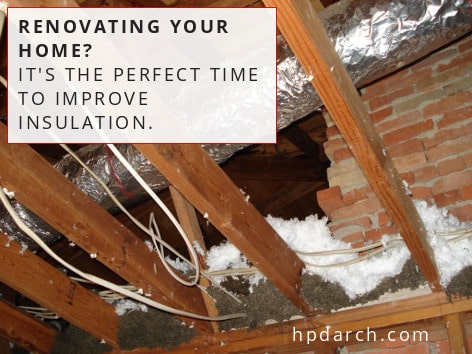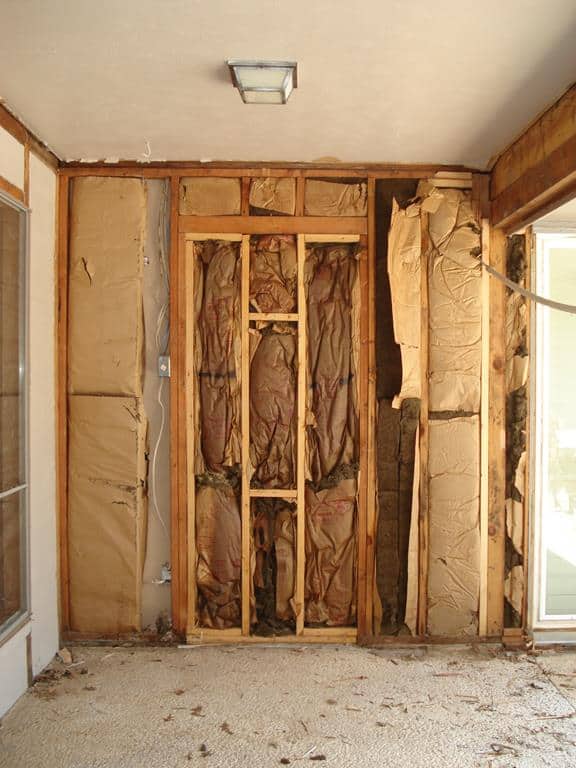After spending a week over the Christmas holiday in a 100+ year old farm house in northern Indiana, I can vouch for the value of quality insulation. If yu are considering renovations it may be the perfect time to look at upgrading your home insulation.
 In the process of the restoring their beloved Indiana farm house, my in-laws moved an exterior wall to put back an open-air porch that once was an original feature on the front of the home. As a result, this exposed the underside of the upstairs bedrooms floors to the outside elements. Adding additional insulation and sealing as many cracks as possible to lessen air infiltration was critical.
In the process of the restoring their beloved Indiana farm house, my in-laws moved an exterior wall to put back an open-air porch that once was an original feature on the front of the home. As a result, this exposed the underside of the upstairs bedrooms floors to the outside elements. Adding additional insulation and sealing as many cracks as possible to lessen air infiltration was critical.
Even with extra care taken in applying layers of insulation between the floor joists and additional bead board paneling to finish the porch ceiling, I couldn’t help but notice (while lying under multiple layers of bedding) that the bedrooms above the porch were noticeably colder than others on the second floor.
So whether you’re building a new home or planning to remodel the one you’re living in, it pays to think about how you’ll insulate (or re-insulate) the building. A little careful planning can help you reduce monthly utility costs and increase overall home comfort and livability for you and your family. Here are some tips about insulation you’ll want to consider:
where should I install insulation
Is “everywhere” too general of an answer? Any surface that separates outside air and inside air from each other will benefit from insulation. The idea is to slow down the transfer of heat energy between areas that differ in temperature. Additionally insulation is good for sound privacy too, but we’ll save that discussion for another day. For thermal protection, at minimum, you need to put insulation in the following places:
- The underside of the roof in a sealed attic or the floor of in a vented attic
- Ceilings
- Exterior walls
- Walls between a garage or porch and living space
- Floors
- Basement walls
Some local building codes also require the foundation and slab be insulated as well.
types of home insulation

Packing too large a piece of batt insulation between studs does not increase the efficiency of the insulation.
In general, the kind of insulation you will need will depend on four things: where you plan to use it, the individual characteristics of your particular home, your local climate, and how much insulation value is required by building codes in your area. Here is a list of the most common insulation types and where builders will generally use them:
1. Fiberglass Batts and Rolls
Batt insulation is a type of insulation made of loosely matted glass fibers that are then fashioned into a blanket-like form. It looks like cotton candy and is very irritating to the skin if you come into contact with it. It is fire resistant and easy to install in floors, ceilings, and walls.
2. Blown-in dry cellulose
This refers to loose insulation made of fiberglass or cellulose that is blown into place with a hose. Fiberglass and cellulose remain loose after they’ve been installed. Blown-in insulation is primarily used in attics and can be used in walls.
3. Expandable spray foam
You may have seen expandable spray polyurethane foam used on home improvement shows. A professional sprays the liquid foam into wall stud cavities, ceilings, and floors. As it cures, the foam expands to fill crevices and then solidifies. This insulation installs quickly and helps remedy air leakage. Be aware that it is more difficult to modify electrical wiring in walls after spray foam hardens.
4. Rigid foam board
This type of insulation is used to add thermal resistance to the exterior walls of a building. Builders often use it with material such as plywood that provides wall strength.
In some areas, building codes require foundation walls to be insulated. To meet code, rigid fiberglass or foam board can be applied to the exterior of the foundation walls and under a slab-on-grade. For maximum benefit, foundation insulation is run from the wall sheathing to the bottom of the foundation wall. We don’t see this much here in Texas, however in climates that experience extended periods of freezing temperatures, the foundation must be insulated past the frost line, which is the depth of soil that can be expected to freeze.
Remember, that upgrading your insulation is just part of the energy efficiency equation. To make the most of your investment be sure to have your home sealed for air leaks. If you are uncertain of how proceed with your home insulation project, a good place to start is with the architects at hpd architecture + interiors. We can advise you on insulation strategies to help you make your home energy efficient no matter the season. Contact us today!
